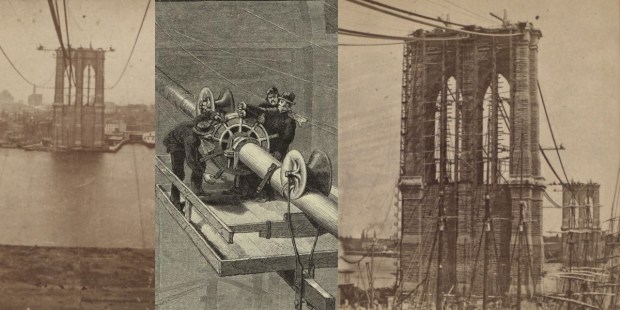In the Preface to his masterwork The Great Bridge, historian David McCullough reminds readers of one of the darkest days in the history of New York City, September 11, 2001. Photographs of the burning World Trade Center in lower Manhattan were splashed on the front page of every newspaper in the country – and on many websites.
But while the focus was on the destroyed Twin Towers, which had become icons of the Big Apple since they opened in the early 1970s, many photos from 9/11 also included another New York icon, the Brooklyn Bridge.
McCullough felt that the bridge’s presence, so close to the site of great destruction, offered a sense of stability for grieving, fearful, outraged New Yorkers – and Americans in general.
“It made one feel something close to what Francis Scott Key felt the morning after the attack on Fort McHenry, seeing the flag ‘still there,’” McCullough mused.
Two bridges, two different fates
Rereading that preface in May 2024, of course, I couldn’t help but make comparisons in my mind between the Brooklyn Bridge and the Francis Scott Key Bridge in Baltimore Harbor, named for the author of our national anthem, to whom McCullough refers. The Key Bridge, much younger than the Brooklyn, collapsed earlier this year when an out-of-control container ship slammed into one of its pillars.
That accident led to the tragic loss of six construction workers on the bridge, and while the Key and the Brooklyn are different kinds of bridges, it would be much more surprising if the latter were to succumb to a similar fate. It’s doubtful, in fact, that even a terrorist attack such as the one that was foiled in the wake of 9/11 could have taken it down.
The history penned by McCullough (1933–2022) is a tome worthy of such a structure. One has the sense that McCullough paid as much attention to the details of every aspect of the bridge’s history as the Roeblings, who built it, paid to the planning and execution of the monumental project.

And two cities joined
McCullough takes us back to a time when Brooklyn and Manhattan were separate cities, long before the incorporation of the five boroughs that make up New York City today. The East River, which separated Brooklyn from New York, could be traversed only by ferry. In winter, of course, that could present problems.
Along came John Augustus Roebling, a German-born wire rope manufacturer from Trenton, New Jersey, who had already built several suspension bridges. Even before the Civil War, he proposed a design for a span across the East River. Construction finally began in 1870, and the bridge, after 13 years of work, would become the world’s first steel-wire suspension bridge.
But how to begin? With the technology that existed in the mid-19th century, how could one build the towers that would hold the suspension cables when water is in the way? McCullough is masterful in describing the building of caissons, the watertight structures filled with compressed air that would enable workers to dig beneath the river and prepare the foundations for the two granite towers that still stand today.
A tale of immigrants, sacrifice, and corruption
Construction was carried out by thousands of workers – many of them immigrants who toiled for about $2 a week. Many of those who worked inside the submerged caissons suffered from a then-mysterious illness that came to be called “the bends,” or decompression sickness. Roebling died early on – from tetanus following an accident – but his son, Washington A. Roebling, carried on as chief engineer, until he too fell victim to the ill effects of decompression sickness and had to supervise the completion from his home in Brooklyn Heights. His wife, Emily Warren Roebling, played a vital role in overseeing the work to its completion.
McCullough also describes the complications that arose from corrupt politicians and crooked contractors that threatened completion of the project – a saga that perhaps would not surprise New Yorkers today.

But finally, on May 24, 1883, the bridge was opened for use – the longest suspension bridge in the world at the time. Its christening was such a big occasion that US President Chester A. Arthur came and joined the mayors of New York and Brooklyn in crossing the span. They then proceeded to Roebling's Brooklyn residence to pay their respects to “the chief engineer.”
I developed such a knowledge and understanding from reading The Great Bridge that I began to feel a kinship to Brooklyn Bridge. Indeed, the next time I had a chance to take a stroll across the bridge’s well-traversed pedestrian walkway, I stopped in front of one of her majestic towers and, reflecting on all that went into the construction – and all that went into the writing of this book – I was moved to tears.



